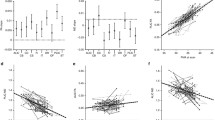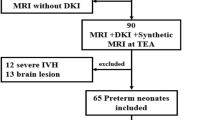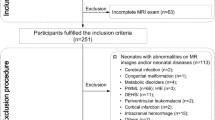Abstract
Introduction
The outcome of premature infants with only diffuse excessive high signal intensity (DEHSI) is not clear. We explored the relationship between DEHSI, white matter (WM) diffusion characteristics, perinatal characteristics, and neurobehavioral outcome at 1 year in a homogenous group of preterm infants without major brain abnormalities.
Methods
Fifty-eight preterm infants, gestational age 29 ± 2.6 weeks, underwent an MRI at term-equivalent age (TEA). Griffiths Mental Developmental Scales, neurological assessment, and Parental Stress Index (PSI) were performed at 1 year corrected age. These measures were compared between preterm infants according to DEHSI classification (none, mild, moderate). Diffusion tensor imaging was used in major WM volumes of interest to objectively measure the degree of WM maturation.
Results
No significant differences were detected in the perinatal risk characteristics, neurobehavioral outcome, and PSI at 1 year between infants with different DEHSI classifications. In infants with DEHSI, increased axial and radial diffusivities were detected in the optic radiations, centrum semiovale, and posterior limb of the internal capsule, indicating less advanced maturation of the WM. Significant correlations were detected between the time interval from birth to MRI and the WM microstructure in infants without DEHSI.
Conclusion
DEHSI in premature infants is neither a predictive measure for short-term adverse neurobehavioral outcome nor related to perinatal risk characteristics. Extrauterine exposure time had a differential effect on WM maturational trajectories in infants with DEHSI compared to those without. We suggest DEHSI may represent an alteration in WM maturational characteristics. Further follow-up studies may verify later consequences of DEHSI in premature infants.




Similar content being viewed by others
References
Anderson P, Doyle LW (2003) Neurobehavioral outcomes of school-age children born extremely low birth weight or very preterm in the 1990s. JAMA 289(24):3264–3272
Potharst ES, van Wassenaer AG, Houtzager BA, van Hus JW, Last BF, Kok JH (2011) High incidence of multi-domain disabilities in very preterm children at five years of age. J Pediatr 159(1):79–85
Bassan H, Limperopoulos C, Visconti K, Mayer DL, Feldman HA, Avery L, Benson CB, Stewart J, Ringer SA, Soul JS, Volpe JJ, du Plessis AJ (2007) Neurodevelopmental outcome in survivors of periventricular hemorrhagic infarction. Pediatrics 120(4):785–792
Mathur A, Inder T (2009) Magnetic resonance imaging—insights into brain injury and outcomes in premature infants. J Commun Disord 42(4):248–255
Mathur AM, Neil JJ, Inder TE (2010) Understanding brain injury and neurodevelopmental disabilities in the preterm infant: the evolving role of advanced magnetic resonance imaging. Semin Perinatol 34(1):57–66
Rutherford MA, Supramaniam V, Ederies A, Chew A, Bassi L, Groppo M, Anjari M, Counsell S, Ramenghi LA (2010) Magnetic resonance imaging of white matter diseases of prematurity. Neuroradiology 52(6):505–521
Dyet LE, Kennea N, Counsell SJ, Maalouf EF, Ajayi-Obe M, Duggan PJ, Harrison M, Allsop JM, Hajnal J, Herlihy AH, Edwards B, Laroche S, Cowan FM, Rutherford MA, Edwards AD (2006) Natural history of brain lesions in extremely preterm infants studied with serial magnetic resonance imaging from birth and neurodevelopmental assessment. Pediatrics 118(2):536–548
Domizio S, Barbante E, Puglielli C, Clementini E, Domizio R, Sabatino GM, Albanese A, Colosimo C, Sabatino G (2005) Excessively high magnetic resonance signal in preterm infants and neuropsychobehavioural follow-up at 2 years. Int J Immunopathol Pharmacol 18(2):365–375
Hart A, Whitby E, Wilkinson S, Alladi S, Paley M, Smith M (2011) Neuro-developmental outcome at 18 months in premature infants with diffuse excessive high signal intensity on MR imaging of the brain. Pediatr Radiol 41(10):1284–1292
Jeon TY, Kim JH, Yoo SY, Eo H, Kwon JY, Lee J, Lee M, Chang YS, Park WS (2012) Neurodevelopmental outcomes in preterm infants: comparison of infants with and without diffuse excessive high signal intensity on MR images at near-term-equivalent age. Radiology 263(2):518–26
Kidokoro H, Anderson PJ, Doyle LW, Neil JJ, Inder TE (2011) High signal intensity on T2-weighted MR imaging at term-equivalent age in preterm infants does not predict 2-year neurodevelopmental outcomes. AJNR Am J Neuroradiol 32(11):2005–10
de Bruine FT, van den Berg-Huysmans AA, Leijser LM, Rijken M, Steggerda SJ, van der Grond J, van Wezel-Meijler G (2011) Clinical implications of MR imaging findings in the white matter in very preterm infants: a 2-year follow-up study. Radiology 261(3):899–906
Pandit AS, Ball G, Edwards AD, Counsell SJ (2013) Diffusion magnetic resonance imaging in preterm brain injury. Neuroradiology 55(Suppl 2):65–95
Parikh NA, He L, Bonfante-Mejia E, Hochhauser L, Wilder PE, Burson K, Kaur S (2013) Automatically quantified diffuse excessive high signal intensity on MRI predicts cognitive development in preterm infants. Pediatr Neurol 49(6):424–430
Cheong JL, Thompson DK, Wang HX, Hunt RW, Anderson PJ, Inder TE, Doyle LW (2009) Abnormal white matter signal on MR imaging is related to abnormal tissue microstructure. AJNR Am J Neuroradiol 30(3):623–628
Counsell SJ, Allsop JM, Harrison MC, Larkman DJ, Kennea NL, Kapellou O, Cowan FM, Hajnal JV, Edwards AD, Rutherford MA (2003) Diffusion-weighted imaging of the brain in preterm infants with focal and diffuse white matter abnormality. Pediatrics 112(1 Pt 1):1–7
Counsell SJ, Shen Y, Boardman JP, Larkman DJ, Kapellou O, Ward P, Allsop JM, Cowan FM, Hajnal JV, Edwards AD, Rutherford MA (2006) Axial and radial diffusivity in preterm infants who have diffuse white matter changes on magnetic resonance imaging at term-equivalent age. Pediatrics 117(2):376–386
Skiold B, Horsch S, Hallberg B, Engstrom M, Nagy Z, Mosskin M, Blennow M, Aden U (2010) White matter changes in extremely preterm infants, a population-based diffusion tensor imaging study. Acta Paediatr 99(6):842–849
Weinstein M, Ben Bashat D, Gross-Tsur V, Leitner Y, Berger I, Marom R, Geva R, Uliel S, Ben-Sira L (2014) Isolated mild white matter signal changes in preterm infants: a regional approach for comparison of cranial ultrasound and MRI findings. J Perinatol. doi:10.1038/jp.2014.33
Volpe JJ (2000) Intracranial hemorrhage. In: Volpe JJ (ed) Neurology of the newborn. WB Saunders Company, Philadelphia, pp 428–493
Mathur AM, Neil JJ, McKinstry RC, Inder TE (2008) Transport, monitoring, and successful brain MR imaging in unsedated neonates. Pediatr Radiol 38(3):260–264
Judas M, Rados M, Jovanov-Milosevic N, Hrabac P, Stern-Padovan R, Kostovic I (2005) Structural, immunocytochemical, and MR imaging properties of periventricular crossroads of growing cortical pathways in preterm infants. AJNR Am J Neuroradiol 26(10):2671–2684
Kostovic I, Judas M, Rados M, Hrabac P (2002) Laminar organization of the human fetal cerebrum revealed by histochemical markers and magnetic resonance imaging. Cereb Cortex 12(5):536–544
Oishi K, Mori S, Donohue PK, Ernst T, Anderson L, Buchthal S, Faria A, Jiang H, Li X, Miller MI, van Zijl PC, Chang L (2011) Multi-contrast human neonatal brain atlas: application to normal neonate development analysis. Neuroimage 56(1):8–20
Griffiths R (1984) The abilities of young children. A comprehensive system of measurement for the first eight years of life. Bucks: Association for Research in Infant and Child Development. The Test Agency, Thames
Loyd BH, Abidin RR (1985) Revision of the Parenting Stress Index. J Pediatr Psychol 10(2):169–177
Schappin R, Wijnroks L, Uniken Venema MM, Jongmans MJ (2013) Rethinking stress in parents of preterm infants: a meta-analysis. PLoS ONE 8(2):e54992
Woodward LJ, Anderson PJ, Austin NC, Howard K, Inder TE (2006) Neonatal MRI to predict neurodevelopmental outcomes in preterm infants. N Engl J Med 355(7):685–694
Sansavini A, Savini S, Guarini A, Broccoli S, Alessandroni R, Faldella G (2011) The effect of gestational age on developmental outcomes: a longitudinal study in the first 2 years of life. Child Care Health Dev 37(1):26–36
Mukherjee P, Miller JH, Shimony JS, Conturo TE, Lee BC, Almli CR, McKinstry RC (2001) Normal brain maturation during childhood: developmental trends characterized with diffusion-tensor MR imaging. Radiology 221(2):349–358
Dubois J, Dehaene-Lambertz G, Perrin M, Mangin JF, Cointepas Y, Duchesnay E, Le Bihan D, Hertz-Pannier L (2008) Asynchrony of the early maturation of white matter bundles in healthy infants: quantitative landmarks revealed noninvasively by diffusion tensor imaging. Hum Brain Mapp 29(1):14–27
Gimenez M, Miranda MJ, Born AP, Nagy Z, Rostrup E, Jernigan TL (2008) Accelerated cerebral white matter development in preterm infants: a voxel-based morphometry study with diffusion tensor MR imaging. Neuroimage 41(3):728–734
Groppo M, Ricci D, Bassi L, Merchant N, Doria V, Arichi T, Allsop JM, Ramenghi L, Fox MJ, Cowan FM, Counsell SJ, Edwards AD (2012) Development of the optic radiations and visual function after premature birth. Cortex
Iwata S, Nakamura T, Hizume E, Kihara H, Takashima S, Matsuishi T, Iwata O (2012) Qualitative brain MRI at term and cognitive outcomes at 9 years after very preterm birth. Pediatrics 129(5):e1138–1147
Ethical standards and patient consent
We declare that all human and animal studies have been approved by the Institutional Review Board of the Ministry of Health and the Hospital Ethics Committee and have therefore been performed in accordance with the ethical standards laid down in the 1964 Declaration of Helsinki and its later amendments. We declare that all participants gave informed consent prior to inclusion in this study.
Conflict of interest
We declare that we have no conflict of interest.
Author information
Authors and Affiliations
Corresponding author
Additional information
Yael Leitner and Maya Weinstein contributed equally to this work.
Rights and permissions
About this article
Cite this article
Leitner, Y., Weinstein, M., Myers, V. et al. Diffuse excessive high signal intensity in low-risk preterm infants at term-equivalent age does not predict outcome at 1 year: a prospective study. Neuroradiology 56, 669–678 (2014). https://doi.org/10.1007/s00234-014-1373-8
Received:
Accepted:
Published:
Issue Date:
DOI: https://doi.org/10.1007/s00234-014-1373-8




